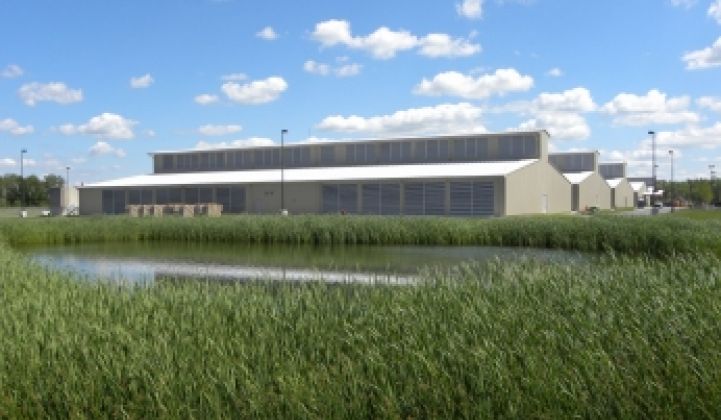When it comes to environmental design, farmers know what they are doing.
Yahoo will unveil a new data center in Lockport, New York tomorrow that boasts a power-use effectiveness (PUE) ratio of 1.08, which means that 92 percent of the power consumed by the data center goes toward computing functions. Only 8 percent goes to lights and operational equipment. Less than 1 percent of the power gets consumed in cooling.
Typical data centers have a PUE of 1.92, which means that roughly half of the power goes to things that aren't computers. Air conditioners gobble up almost as much, and sometimes more, than servers in these data centers.
The lack of a need for mechanical air conditioning in Yahoo's data center means that the data center will require about 40 percent less power than average and will consume 95 percent less water. Air conditioning is primed to be a green growth market.
Chalk it up to location and design. Lockport, near Buffalo in the western part of the state, sits in the path of lake winds. The cold air is directed into the the data center through devices called economizers. The building, moreover, is unusually tall and narrow and is topped with a cupola: the shape and design effectively help channel the warm air from the hot aisles in the data center outdoors.
"It was inspired by the design of chicken coops," said Christina Page, director of climate and energy strategy at Yahoo.
Look at the picture of the data center: it looks like it came straight out of a Foghorn Leghorn cartoon. The resemblance is uncanny. Green architect Michelle Kaufmann once told me that barns in many ways are fantastic examples of architecture because of the way they integrate function with their environment. Here's more proof.
The data center -- which consumes 15 megawatts -- gets its power from Niagara Falls.
Other factors -- besides clean power and natural, free air conditioning -- that played into Yahoo's decision to locate in Lockport: plenty of technology talent and local universities, good bandwidth, proximity to large population centers for reducing latency and incentives from the state of New York.
Google has a quarterly average PUE of 1.17, with an individual facility hitting 1.13. Thus, Google probably has an overall corporate PUE rating that bests Yahoo's, but Yahoo has the current record between the two for a single data center. It's about time Yahoo won something. (Side note: I once tried to live a month without Google. I broke down after I couldn't find a Yahoo-NEC press release on Yahoo. It was the first result on Google.)
PUE, of course, is only one measure of a data center's efficiency. If it were stocked with old Commodore computers, the bill would be unusually high. This is the first phase of the data center. Yahoo will next examine ways to improve the efficiency of the power supplies for the data center. It will also study the possibility of LED lighting, something other data centers have begun to adopt.
It also continues to study emerging technologies for reducing computer power consumption: flash memory storage systems, automated data center monitoring, application shifting and pushing the envelope on virtualization.



